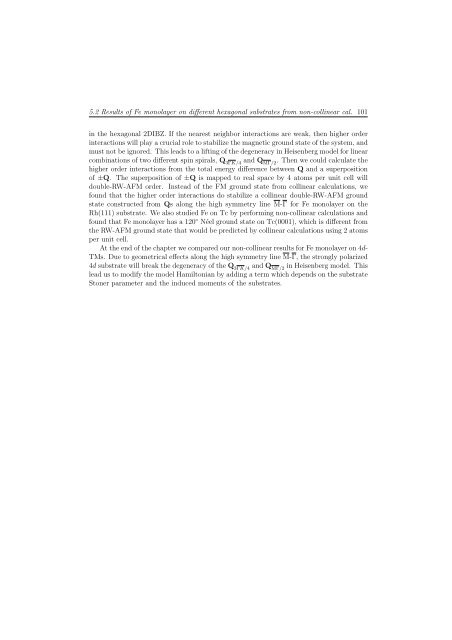Ab initio investigations of magnetic properties of ultrathin transition ...
Ab initio investigations of magnetic properties of ultrathin transition ...
Ab initio investigations of magnetic properties of ultrathin transition ...
You also want an ePaper? Increase the reach of your titles
YUMPU automatically turns print PDFs into web optimized ePapers that Google loves.
5.2 Results <strong>of</strong> Fe monolayer on different hexagonal substrates from non-collinear cal. 101<br />
in the hexagonal 2DIBZ. If the nearest neighbor interactions are weak, then higher order<br />
interactions will play a crucial role to stabilize the <strong>magnetic</strong> ground state <strong>of</strong> the system, and<br />
must not be ignored. This leads to a lifting <strong>of</strong> the degeneracy in Heisenberg model for linear<br />
combinations <strong>of</strong> two different spin spirals, Q 3ΓK/4 and Q MΓ/2 . Then we could calculate the<br />
higher order interactions from the total energy difference between Q and a superposition<br />
<strong>of</strong> ±Q. The superposition <strong>of</strong> ±Q is mapped to real space by 4 atoms per unit cell will<br />
double-RW-AFM order. Instead <strong>of</strong> the FM ground state from collinear calculations, we<br />
found that the higher order interactions do stabilize a collinear double-RW-AFM ground<br />
state constructed from Qs along the high symmetry line M-Γ for Fe monolayer on the<br />
Rh(111) substrate. We also studied Fe on Tc by performing non-collinear calculations and<br />
found that Fe monolayer has a 120 ◦ Néel ground state on Tc(0001), which is different from<br />
the RW-AFM ground state that would be predicted by collinear calculations using 2 atoms<br />
per unit cell.<br />
At the end <strong>of</strong> the chapter we compared our non-collinear results for Fe monolayer on 4d-<br />
TMs. Due to geometrical effects along the high symmetry line M-Γ, the strongly polarized<br />
4d substrate will break the degeneracy <strong>of</strong> the Q 3ΓK/4 and Q MΓ/2 in Heisenberg model. This<br />
lead us to modify the model Hamiltonian by adding a term which depends on the substrate<br />
Stoner parameter and the induced moments <strong>of</strong> the substrates.

















